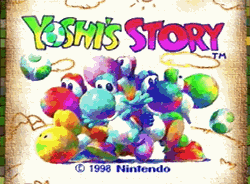 Here rests Nintendo’s final arcade game.
Here rests Nintendo’s final arcade game.
Nintendo once produced the best of the best for the arcades, the birthplace of Donkey Kong, Mario, and… Pauline? Er… Let’s go with Luigi. Before the NES opened the gates to the Mushroom Kingdom, you could control Mario and friends for a mere quarter, and dodge barrels and turtles to your heart’s content. The hammer was the most powerful powerup available, and collecting oddly mundane items like umbrellas gradually gave way to Mario’s lifelong addiction to coin collecting.
The days of Nintendo’s arcade dominance quickly gave way to its console dominance, where duck hunting and random robots ruled. Nintendo did, at least, seem to continue producing arcade games through the life and death of the arcade, even repackaging much of the SNES launch into a pay-per-minute arcade cabinet. It may have simply been a marketing tool, but 25¢ was about 800 times cheaper than the alternative cost to ride a dinosaur and devour goombas.
Nintendo may have left the idea of original arcade content in the dust pretty quickly, but you could always see the influence it left on its console output. Mario always had an arcade style “score” through to Yoshi’s Island, and then adopted a sort of “level report card” that, in the end, was much the same thing, just with a few less zeros. Many Nintendo games, from Punch-Out to NES Tetris, featured prominent scores, and even games like Kid Icarus kept track of your “points” for a final “high score” reward. The Legend of Zelda didn’t have a score, but the way it ranked your heart containers to determine sword distribution speaks to how Nintendo was still thinking of points as a measurement as opposed to the “do you have the hookshot?” of later games.
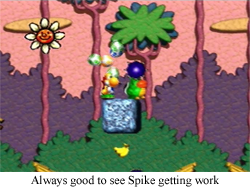 I would say, as a result of no research greater than my own faulty memory (which is already proving to be terrible: where was the score in Super Mario Bros. 2, smart guy?), that the turning point was Donkey Kong Country, the game that changed the idea of a “score” into “percent complete”. No more could you just bop atop a respawning goomba over and over for the highest score available; no, now you must find all the concealed baubles and beads meticulously hidden in every stage (except the stages where they forgot to hide anything). The “collectathon” was born, and the only “high score” available was a flat 100% (give or take a percent or three). Want to know my high score in Super Mario 64? It’s 120 stars, probably the same as many of you. Yes, it’s possible to have individual high score coin counts on certain stages, but once you clear a hundred and earn a star, well, who cares?
I would say, as a result of no research greater than my own faulty memory (which is already proving to be terrible: where was the score in Super Mario Bros. 2, smart guy?), that the turning point was Donkey Kong Country, the game that changed the idea of a “score” into “percent complete”. No more could you just bop atop a respawning goomba over and over for the highest score available; no, now you must find all the concealed baubles and beads meticulously hidden in every stage (except the stages where they forgot to hide anything). The “collectathon” was born, and the only “high score” available was a flat 100% (give or take a percent or three). Want to know my high score in Super Mario 64? It’s 120 stars, probably the same as many of you. Yes, it’s possible to have individual high score coin counts on certain stages, but once you clear a hundred and earn a star, well, who cares?
And it’s straddling this fine line between “high score” and “completion” that we find Yoshi’s Story. Yoshi’s Story had an uphill climb from it’s very inception, as it had the unenviable task of competing with, and hopefully innovating on, its predecessor Yoshi’s Island, a game so good and timeless that I just had to retype the start of this paragraph as I had been reflexively typing “Yoshi’s Island” instead of “Yoshi’s Story”. Even when it was new, Yoshi’s Island clearly presented itself as another genre defining SNES release, like Super Metroid, Kirby Super Star, or the previously mentioned Donkey Kong Country. Now, Nintendo had to produce its direct sequel on a system that was built for the exact opposite of everything that made Yoshi’s Island memorable. In response to this mounting pressure, Nintendo made the decision to go completely insane.
Let’s be clear here: Yoshi’s Story is a collectathon in the vein of its immediate prequel and Donkey Kong Country. Yoshi’s goal in every level is to collect thirty melons amidst the obstacle course that is every stage. This is not dissimilar from collecting every last red coin in Yoshi’s previous adventure, but with one terrible difference: every metaphorical yellow coin “counts”. Yes, Yoshi’s top goal is to collect thirty melons, but Yoshi will complete the level after collecting thirty of any fruit, whether it be melon, grape, banana, or pepper (which, if you’re unaware, is a fruit, due to the way its seeds work. Related, eggplants are berries for some reason). So Yoshi’s goal is to collect only the best fruit for only the best score, and screw your natural video game honed reflexes to collect every single fruit. This sounds like a neat concept in theory, but in practice, everyone’s first impulse is to grab everything they see, which will lead to a level being completed in, roughly, two minutes. Keep this up through the six available worlds, and Yoshi’s Story can be completed, easily, in less than an hour.
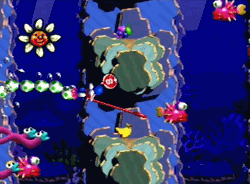 This is Yoshi’s Story’s other great sin: there are 24 stages, but you will only ever see a maximum of six during a single playthrough. This isn’t some challenging “maybe you missed something” scenario, either, you could play each (available) level in Yoshi’s Story perfectly, and you will only be able to see a maximum of a quarter of the game’s content before the credits roll. And, even better, to unlock 75% of those levels, you have to find “hearts” hidden in your immediate level, so it’s entirely possible to even miss the option of playing anything but the same six stages if your searching skills are subpar. Yoshi’s Story is possibly the most punishing game I’ve ever played where I didn’t lose a life.
This is Yoshi’s Story’s other great sin: there are 24 stages, but you will only ever see a maximum of six during a single playthrough. This isn’t some challenging “maybe you missed something” scenario, either, you could play each (available) level in Yoshi’s Story perfectly, and you will only be able to see a maximum of a quarter of the game’s content before the credits roll. And, even better, to unlock 75% of those levels, you have to find “hearts” hidden in your immediate level, so it’s entirely possible to even miss the option of playing anything but the same six stages if your searching skills are subpar. Yoshi’s Story is possibly the most punishing game I’ve ever played where I didn’t lose a life.
And you have to remember that this was released during the age that the collectathon and 100% completion was reaching its fever pitch. Okay, yes, we still live in a gaming landscape where “platinuming” or bleeding a game for its every last achievement is the norm, but this was when the advent of memory cards and abundant save batteries meant you could find every dang secret and treasure and your game would remember it, and you could parade that completed cartridge through the streets, forcing peons to bow to your DK Coin collecting glory. Fighting Games, that silly genre where “100%” used to just mean “I beat Bison”, were just starting to get into that repugnant decade or so of having to complete every challenge available just to play with the full roster. And here stands Yoshi’s Story, a game where you might be the best, most completitionist player in history, and all you’ll get as a reward is a playthrough of ¼ of the game and an abstract high score. You don’t even unlock, I don’t know, a winged yoshi for your troubles.
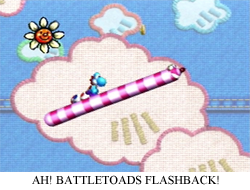 Yoshi’s Story, as many claimed at the time, was a lousy console game. It was aping a gameplay style that, frankly, was as extinct as green raptors. Yoshi’s Story could have worked as the ultimate arcade game, though. Think about it: a dedicated one-player game that changes with every playthrough, allowing good players to take more advanced routes and less skilled, likely child players taking the easy way to an equally valid victory. Modify the health/lives system so you’d need a few more credits to complete the game (it’s a livin’), and Yoshi’s Story could have revitalized the arcades that, at the time, were just fading Street Fighter and Mortal Kombat mausoleums. Hey, Yoshi’s vaguely claymation aesthetics would have looked just right next to Rampage: World Tour. High scores don’t mean a thing when they’re just sitting on your N64 on a single player cart, but they mean the world when everyone for ten square miles can envy the amazing gaming skills of ASS.
Yoshi’s Story, as many claimed at the time, was a lousy console game. It was aping a gameplay style that, frankly, was as extinct as green raptors. Yoshi’s Story could have worked as the ultimate arcade game, though. Think about it: a dedicated one-player game that changes with every playthrough, allowing good players to take more advanced routes and less skilled, likely child players taking the easy way to an equally valid victory. Modify the health/lives system so you’d need a few more credits to complete the game (it’s a livin’), and Yoshi’s Story could have revitalized the arcades that, at the time, were just fading Street Fighter and Mortal Kombat mausoleums. Hey, Yoshi’s vaguely claymation aesthetics would have looked just right next to Rampage: World Tour. High scores don’t mean a thing when they’re just sitting on your N64 on a single player cart, but they mean the world when everyone for ten square miles can envy the amazing gaming skills of ASS.
Nintendo, next time you get an idea like this, remember the arcade. Do it for ASS. Do it for the ASS in all of us.
FGC #39 Yoshi’s Story
- System: N64, much to my lament. Wii barely sneaks in.
- Number of Players: One yoshi of a variety of colors.
- Favorite Yoshi Color: Hot Pink. Bless you, you apple loving dinosaur.
- Number of times I had to check to make sure I’d written “Yoshi’s Story” and not “Yoshi’s Island”: ∞
- Highest Score: And the vaguely angry tone of this article has nothing to do with the fact that my save battery apparently crapped out on remembering all the blood, sweat, and tears I put into finding all those melons. On a related note, the best feature on the PS3 is being able to backup PS1 memory cards.
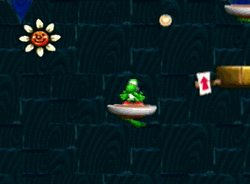 Shy Genocide: Also, like the number one, non-fruit way to score points in this game is to just wreck every Shy Guy you can see. Hop, stomp, toss, or eat, it doesn’t matter, just destroy them all. I really have to question why Shy Guys even go near Yoshi’s Island. At least goombas are soldiers, shy guys are just strolling through Jurassic Park every day of their short lives.
Shy Genocide: Also, like the number one, non-fruit way to score points in this game is to just wreck every Shy Guy you can see. Hop, stomp, toss, or eat, it doesn’t matter, just destroy them all. I really have to question why Shy Guys even go near Yoshi’s Island. At least goombas are soldiers, shy guys are just strolling through Jurassic Park every day of their short lives.- Did you know? Apparently the voice samples created for the Yoshi Tribe for this game were reused for the next decade or so of Yoshi appearances. It’s kind of funny to hear that while playing the game, because, in the intervening seventeen years or so, I’ve heard these same sound effects over and over again, but even remotely similar graphics used basically never. The N64 era was such an evolutionary dead-end for aesthetics.
- Would I play again: You know what? This game would also be super ideal for a 3DS Virtual Console or similar rerelease. I would love to play through the game in a spare hour or so while watching a particularly uninteresting movie or waiting in line for an Amiibo, but it’s unlikely I’m firing up the N64 to dominate my television for a run-through. Of course, even then, I’d prefer a “perfect” Yoshi’s Island before Yoshi’s Story, and even that is unlikely, so the answer is probably no.
What’s Next? Random ROB has chosen…. Playstation All-Stars Battle Royale. Finally, someone made a game based on my Fat Princess/Big Daddy fanfic! Please look forward to it!
I hate collectathons. I refuse to get 100% in anything I play.
[…] thus far during the challenge, so that’s a mere 7% of all games played. Of those games, I’d say Yoshi’s Story was the most aesthetically pleasing, which is no surprise, as I think it’s publically regarded as […]
[…] was released in the age of the score, those halcyon days when, in the transition from arcade to home console, every game had to have a […]
[…] the storybook imagery seems a lot like what would eventually become a staple of Nintendo’s own Yoshi’s Whatever series. Couple this all with good (not great, but a lot better than a lot on the SNES) level […]
[…] the vein of the previous Super Mario World titles. There were dinosaurs and flying hammer bros. and Spike and all manner of piranha plants. In fact, there were also “recursive” appearances, like Super […]
[…] Even some Nintendo mascots that are supposed to be species are generally regarded as singular. Yoshi is that “one” Yoshi from Super Mario World, and Pikachu is “Ash’s Pikachu”, star of stage […]